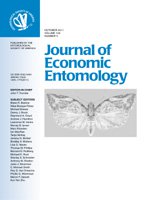Phosphine fumigations under superatmospheric oxygen levels (oxygenated phosphine fumigations) were significantly more effective than the fumigations under the normal 20.9% atmospheric oxygen level against western flower thrips [Frankliniella occidentalis (Pergande)] adults and larvae, leafminer Liriomyza langei Frick pupae, grape mealybug [Pseudococcus maritimus (Ehrhorn)] eggs, and Indianmeal moth [Plodia interpunctella (Hübner)] eggs and pupae. In 5-h fumigations with 1,000 ppm phosphine at 5°C, mortalities of western flower thrips increased significantly from 79.5 to 97.7% when oxygen was increased from 20.9 to 40% and reached 99.3% under 80% O2. Survivorships of leafminer pupae decreased significantly from 71.2% under 20.9% O2 to 16.2% under 40% O2 and reached 1.1% under 80% O2 in 24-h fumigations with 500 ppm phosphine at 5°C. Complete control of leafminer pupae was achieved in 24-h fumigations with 1,000 ppm phosphine at 5°C under 60% O2 or higher. Survivorships of grape mealybug eggs also decreased significantly in 48-h fumigations with 1,000 ppm phosphine at 2°C under 60% O2 compared with the fumigations under 20.9% O2. Indianmeal moth egg survivorships decreased significantly from 17.4 to 0.5% in responses to an oxygen level increase from 20.9 to 40% in 48-h fumigations with 1,000 ppm phosphine at 10°C and reached 0.2% in fumigations under 80% O2. When the oxygen level was reduced from 20.9 to 15 and 10% in fumigations, survivorships of Indianmeal moth eggs increased significantly from 17.4 to 32.9 and 39.9%, respectively. Increased O2 levels also resulted in significantly lower survival rates of Indianmeal moth pupae in response to 24-h fumigations with 500 and 1,000 ppm phosphine at 10°C and a complete control was achieved in the 1,000 ppm phosphine fumigations under 60% O2. Oxygenated phosphine fumigations have marked potential to improve insecticidal efficacy. Advantages and limitations of oxygenated phosphine fumigation are discussed.
How to translate text using browser tools
1 October 2011
Oxygen Enhances Phosphine Toxicity for Postharvest Pest Control
Yong-Biao Liu
ACCESS THE FULL ARTICLE
It is not available for individual sale.
This article is only available to subscribers.
It is not available for individual sale.
It is not available for individual sale.

Journal of Economic Entomology
Vol. 104 • No. 5
October 2011
Vol. 104 • No. 5
October 2011
oxygen
phosphine fumigation
postharvest pest control
stored product




